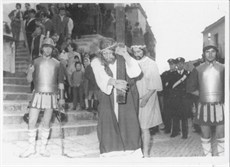The Via Crucis of Barile (Potenza)
 The Way of the Cross of Barile, a small town of Vulture Melfese that still speaks an ancient language of Albanian origin (Arberesco), is one of the last and most impressive processions with living characters that takes place in southern Italy. In May of 1983, a version of the solemn procession was held in the Vatican City, in the presence of Pope John Paul II. Its origins seem to date back to the seventeenth century, when the drama of Christ was staged for the first time by a sextan on the margins of the rites of the Easter liturgy. Today you can admire this spectacular tradition in some of the surrounding municipalities (Rapolla, Atella, Maschito, Venosa and Rionero in Vulture).
The Way of the Cross of Barile, a small town of Vulture Melfese that still speaks an ancient language of Albanian origin (Arberesco), is one of the last and most impressive processions with living characters that takes place in southern Italy. In May of 1983, a version of the solemn procession was held in the Vatican City, in the presence of Pope John Paul II. Its origins seem to date back to the seventeenth century, when the drama of Christ was staged for the first time by a sextan on the margins of the rites of the Easter liturgy. Today you can admire this spectacular tradition in some of the surrounding municipalities (Rapolla, Atella, Maschito, Venosa and Rionero in Vulture).
 The Sacred Representation of Barile begins with the religious function at the ninth hour (three o’clock in the afternoon according to our clock), exactly at the moment when Jesus died on the cross two thousand years before. The procession, which commemorates the Passion and Death of Christ, files out in the evocative setting of the historic centre. It includes over one hundred participants, divided into 25 groups. The gloomy atmosphere which leads the Way of the Cross symbolizes the guilt of Christians. The mournful procession, opened by the Roman Centurions and the Marys, requires the presence of three different images of Christ. In addition to the one that lifelessly drags the Cross, followed by a moving Virgin Mary terrified by the pain, the representation of Christ also comprises a flogged Christ and an Ecce homo, holding a cane scepter. There is no shortage of actors who impersonate the haughty priests of the Sanhedrin. The procession of Barile is also distinguished by the presence of the Gypsy and Moor. The first, decked with precious jewels, personifies lust and the guilty indifference of men about the fate of the Redeemer. According to tradition she was the manufacturer of the nails used in the Crucifixion. The Moor, however, according to local scholars, symbolizes the Turkish invader that forced the Albanians to move to Barile. This figure is also present in the procession of the Giants that are present in many cities of Calabria and Sicily, often accompanied or replaced by camel. As usual, they are opaque symbols, which have accumulated so many legends as to make it almost impossible (and even unnecessary) to trace their origins.
The Sacred Representation of Barile begins with the religious function at the ninth hour (three o’clock in the afternoon according to our clock), exactly at the moment when Jesus died on the cross two thousand years before. The procession, which commemorates the Passion and Death of Christ, files out in the evocative setting of the historic centre. It includes over one hundred participants, divided into 25 groups. The gloomy atmosphere which leads the Way of the Cross symbolizes the guilt of Christians. The mournful procession, opened by the Roman Centurions and the Marys, requires the presence of three different images of Christ. In addition to the one that lifelessly drags the Cross, followed by a moving Virgin Mary terrified by the pain, the representation of Christ also comprises a flogged Christ and an Ecce homo, holding a cane scepter. There is no shortage of actors who impersonate the haughty priests of the Sanhedrin. The procession of Barile is also distinguished by the presence of the Gypsy and Moor. The first, decked with precious jewels, personifies lust and the guilty indifference of men about the fate of the Redeemer. According to tradition she was the manufacturer of the nails used in the Crucifixion. The Moor, however, according to local scholars, symbolizes the Turkish invader that forced the Albanians to move to Barile. This figure is also present in the procession of the Giants that are present in many cities of Calabria and Sicily, often accompanied or replaced by camel. As usual, they are opaque symbols, which have accumulated so many legends as to make it almost impossible (and even unnecessary) to trace their origins.
